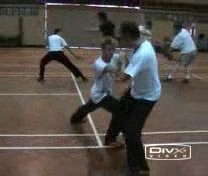IMPROVING TECHNIQUES AND FLOW IN FREE SPARRING
OVERVIEW

As attacks come randomly in free sparring, can pre-arranged sequences be useful? It is similar to asking since traffic flow on real roads is never pre-arranged, or opponents in a football match can play in countless different ways, is it useful to practice driving using predetermined tasks (like turning right and going uphill) or practicing pre-arranged attacking and defending formations in football.
Not only it is useful, it is necessary if one wishes to be proficient in driving, playing football or kungfu sparring. A failure to understand this philosophy is one major cause of the pathetic low level of kungfu sparring today.
In our school, Shaolin Wahnam, there are a few methods to transform pre-arranged combat sequences to spontaneous free sparring. One such method is called “Subtraction and Addition”. Another method is shown here, and for convenience is called “Punctuated Free Sparring”. Sparring may be broadly classified into two categories — pre-arranged and free. For our training purposes, we classify “Pre-Arranged Sparring” into the following groups:
- Miscellaneous Techniques
- Combat Sequences
- Combination Sets
When we practice “Miscellaneous Techniques” (“san sau” in Cantonese pronunciation, also called “one-step sparring”) we perform a pre-chosen defence against a pre-chosen attack. When we practice “Combat Sequences” (“wooi hap tui ta”) we perform series of pre-arranged attacks and defences. When we practice “Combination Sets” (“tui chak”, called “two-man set” in some literature), we perform complete sets of pre-arranged attacks and defences.
Also for our training purposes, we differentiate “Free Sparring” into the following types:
- Conditioned Free Sparring
- Punctuated Free Sparring
- Unconditioned Free Sparring
In “Conditioned Free Sparring” (“thiew han san ta”), the movements are not pre-arranged but are abide by certain conditions, such as they must be only hand strikes, or must be chosen form specified combat sequences in certain order. In “Punctuated Free Sparring” (“cham chun san ta”), training partners purposely slow down or freeze their movements to allow their partners time to come out with appropriate responses. “Unconditioned Free Sparring” (“mo thiew san ta”) is what most people regard free sparring to be, without any conditions, except of course for such consideration like holding back force so as not to hurt the training partners.
- Slowing down Sparring for Better Understanding
- Anticipating Opponents' Moves and Responding with Prepared Counters
- Helping your Sparring Partner to Progress
- Purposely Slowing Down and Sparring Without Muscular Tension
- Freezing Attacks for Sparring Partner to respond
- Tempting Opponent to Attack and Responding with Surprised Kick
- What would You Do if your Kicking leg is Caught?
- Learning from Mistakes in Friendly Sparring
- Exploiding Advantage for Decisive Strike
- Tiger-Claws and Throws
- A Snake, a Kick and another Snake
- Spectacular Chi Flow after Free Sparring
LINKS
